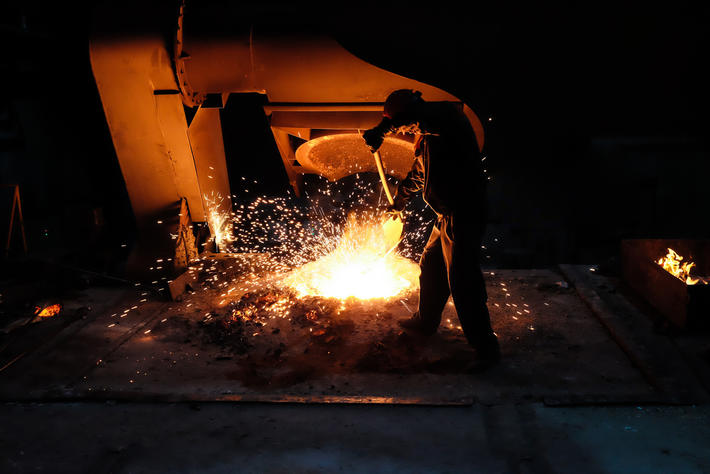
Five priorities for a decarbonised, resilient and competitive aluminium industry
As a strategic raw material, aluminium contributes significantly to the EU’s commitment to the objective of climate neutrality by 2050. A competitive European aluminium industry is therefore essential to achieve a green transition that is “made in Europe”.
A thriving light metal industry not only ensures reliability in the supply chain, but also fosters innovation, job creation and economic growth.
In charting its path towards a sustainable future, the Italian aluminium industry, through Assomet, calls on policymakers to lay the foundations for a resilient, environmentally friendly and globally competitive economy by taking into account five aspects and priorities.
Priorities for a decarbonised aluminium industry
1. Develop an effective industrial strategy that encourages investment in Europe
Promoting sustainable investment in aluminium industries is key to the green transition. The EU has the task of offering a forward-looking industrial policy, while facilitating faster and more secure access to resources. To maximise this impact, Europe must implement development plans for key industries that ensure sustainability and investment. Initiatives such as the American “InflationReduction Act” have made investment more attractive in other areas.
It is essential to secure the future of “made in Europe” industries by mitigating energy costs; this is why we call on politicians to design a European sovereign fund to support industrial competitiveness and decarbonisation. This solution should be accompanied by a lending platform managed by the European Investment Bank. An effective industrial strategy should be led by an Executive Commissioner who can provide cross-cutting supervision across Directorates-General (DGs) to ensure effective coordination and implementation of ad hoc policies established by the EU.
2. Promote a green transition “made in Europe”
In view of the growing demand for aluminium expected for the green transition and in order to reach the 2030 benchmarks for raw material production indicated by the Critical RawMaterials Act (CRMA), we call on politicians to promote initiatives that can help our industry to start new capacities and/or recover those reduced in the meantime. This means increasing recycling activities, strengthening the connection between raw materials, clean technologies and products manufactured in Europe. It is essential to use the momentum provided by the Green Deal to support the wider production of Critical RawMaterial and the Net-Zero Industry Act.
Together we can unlock a real “renovation wave” that improves the energy performance of existing buildings, in line with the principles of energy efficiency. To achieve this, it will be necessary to focus on the replacement of construction elements that are part of the building envelope, such as windows, curtain walls, cladding and roof coverings.
3. Keep energy prices competitive internationally
To facilitate industrial decarbonisation that is adapted to the needs of energy-intensive sectors exposed to international competition, such as the aluminium industry, Europe needs a rapid and cost-effective implementation of green energy solutions. It is essential to establish a comprehensive legislative framework to promote investment in decarbonisation technologies. This requires accelerating the uptake of Power Purchase Agreements (PPAs) by implementing the provisions agreed in the latest Electricity Market Design Reform (EMD), encouraging national or EU public guarantee schemes for PPAs and reducing the costs of modelling decarbonised electricity consumption through increasing use of renewable energy. It is also necessary to strengthen the State Aid Guidelines for Climate, Energy and the Environment (CEEAG) to support the consumption of decarbonised electricity and gas.
It also appears crucial to prioritise the maintenance and strengthening of existing carbon leakage protection measures, namely free allocation under the EU Emissions Trading System (ETS) and indirect cost compensation. Indeed, the new Carbon Border Adjustment Mechanism (CBAM) in its current design does not provide carbon leakage protection for the aluminium value chain. It needs to be adapted to the specificities of the electricity-intensive and price-taking context of aluminium and should fully reflect the carbon costs of the EU ETS and existing gaps need to be filled.
Therefore, the CBAM on aluminium imports should only apply to direct emissions and the ETS indirect cost compensation scheme should remain a carbon leakage protection tool for electricity-intensive industries.
An ETS reform that rewards strategic and circular industries, such as aluminium, is desirable, by introducing a separate ETS benchmarking methodology for aluminium recycling, as well as a separate ETS “product benchmark” for alumina production, which would more accurately reflect the level of CO2 emissions.
4. Revitalize trade defense policies
To reduce Italy and the European Union’s dependence on third countries and the influx of carbon-intensive imports, it appears essential to adopt a stronger stance against imports from countries with non-market economies. The EU’s trade defense instruments (TDI) have so far proven insufficient to maintain the necessary level of protection for the aluminum industry. A more pragmatic approach is needed, including more ex officio cases and greater prevention of trade circumvention.
As highlighted by several OECD reports, the light metal supply chain is disproportionately exposed to market distortions – in the form of aid and subsidies – mainly generated by China. This unfair competition undermines the sustainability and growth of the entire European aluminum value chain.
To combat global emissions and address excess non-market capacity, one solution would be to establish a robust EU-US agreement on sustainable aluminum based on a level playing field in production costs.
5. Managing chemicals in line with the circular economy
The success of the European industry depends on its ability to compete on an equal footing with other global players, while ensuring maximum circularity and low carbon emissions for the foreseeable future.
The aluminium industry therefore strongly supports a review of REACH that balances the critical role of socio-economic analysis with the overall sustainable management of chemicals and that does not conflict with the EU's circular economy strategies.
More effective monitoring of imports of semi-finished or finished products containing substances of very high concern (SVHC) or substances of concern (SoC) is also needed.
Source: A&L Aluminium Alloys Pressure Diecasting Foundry Tecniques


